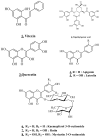Traditional Knowledge, Phytochemistry, and Biological Properties of Vachellia tortilis
- PMID: 36501387
- PMCID: PMC9737653
- DOI: 10.3390/plants11233348
Traditional Knowledge, Phytochemistry, and Biological Properties of Vachellia tortilis
Abstract
Vachellia tortilis is a medicinal plant of the Fabaceae family, widely distributed in arid and semi-arid regions of North, East and Southern Africa, the Middle East and the Arabian Peninsula. In traditional medicine. It's commonly used to treat certain ailments, including diabetes, asthma, hepatitis and burns. Different scientific search databases were used to obtain data on V. tortilis, notably Google Scholar, Scopus, Wiley Online, Scifinder, Web of Science, ScienceDirect, SpringerLink, and PubMed. The knowledge of V. tortilis was organized based on ethnomedicinal use, phytochemistry, and pharmacological investigations. Phytochemical studies revealed the presence of a variety of phytocompounds, including fatty acids, monosaccharides, flavonoids, chalcones, and alcohols. Essential oils and organic extracts prepared from V. tortilis showed several biological properties, specifically antibacterial, antifungal, antiparasitic, antioxidant, antiproliferative, anti-diabetic, and anti-inflammatory effects. Antimicrobial and antiparasitic activities are due to the disturbance of cellular membranes and ultra-structural changes triggered by V. tortilis phytochemicals. While physiological and molecular processes such as apoptosis induction, preventing cell proliferation, and inflammatory mediators are responsible for the anti-diabetic, anti-cancer, and anti-inflammatory activities. However, further investigations concerning pharmacodynamics and pharmacokinetics should be carried out to validate their clinical applications.
Keywords: Fabaceae family; Vachellia tortilis; antimicrobial activities; bioactive compounds; medicinal use; pharmacological effects.
Conflict of interest statement
The authors declare no conflict of interest.
Figures






References
-
- Abouri M., Mousadik A.E., Msanda F., Boubaker H., Saadi B., Cherifi K. An ethnobotanical survey of medicinal plants used in the Tata Province, Morocco. Int. J. Med. Plants Res. 2012;27:99–123.
-
- Jaouadi W., Mechergui K., Ammari Y., Hamrouni L., Hanana M., Khouja M.L. Étude ethnobotanique et ethnopharmacologique d’Acacia tortilis (Forssk) Hayne subsp. raddiana (Savi) de la steppe arborée du Nord de l’Afrique. Phytothérapie. 2016;14:285–292. doi: 10.1007/s10298-015-0951-1. - DOI
-
- Ali M.R., EL Said R.M. Assessment of the potential of Arabic gum as an antimicrobial and antioxidant agent in developing vegan “egg-free” mayonnaise. J. Food Saf. 2020;40:e12771. doi: 10.1111/jfs.12771. - DOI
-
- Ziani B.E.C., Carocho M., Abreu R.M.V., Bachari K., Alves M.J., Calhelha R.C., Talhi O., Barros L., Ferreira I.C.F.R. Phenolic profiling, biological activities and in silico studies of Acacia tortilis (Forssk.) Hayne ssp. raddiana extracts. Food Biosci. 2020;36:100616. doi: 10.1016/j.fbio.2020.100616. - DOI
-
- Abdllha H.B., Mohamed A.I., Almoniem K.A., Adam N.I., Alhaadi W., Elshikh A.A., Ali A.J., Makuar I.G., Elnazeer A.M., Elrofaei N.A., et al. Evolution of Antimicrobial, Antioxidant Potentials and Phytochemical Studies of Three Solvent Extracts of Five Species from Acacia Used in Sudanese Ethnomedicine. AiM. 2016;6:691–698. doi: 10.4236/aim.2016.69068. - DOI
Publication types
LinkOut - more resources
Full Text Sources
Molecular Biology Databases

